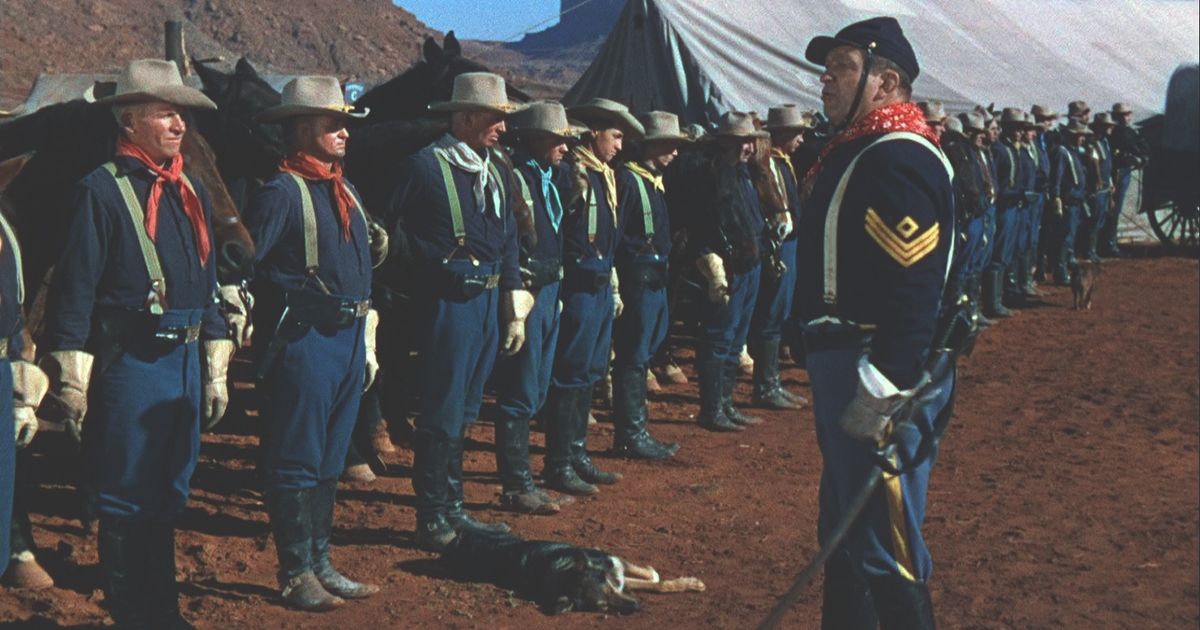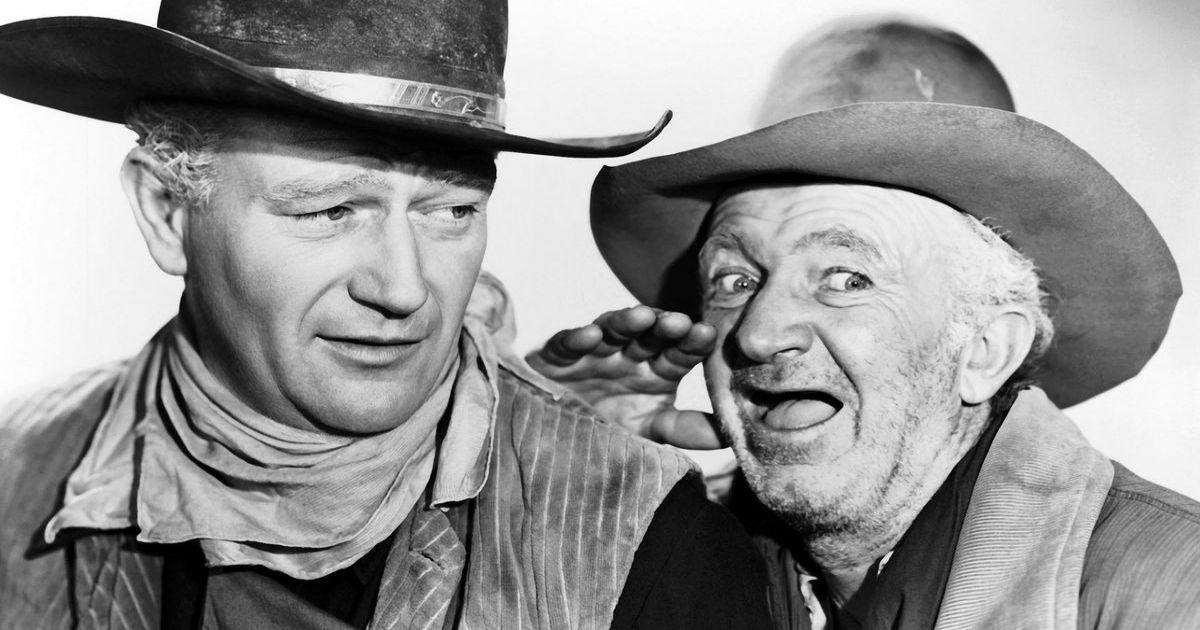John Wayne became an icon over the course of his career, particularly from his roles in war and great western movies throughout Hollywood’s Golden Age. Fans of Wayne might also know him as The Duke, which is a nickname that stuck with him since his childhood. As a young boy, Wayne’s best friend was his dog Duke, and when he befriended a local fireman, who called the dog Big Duke and Wayne Little Duke, the nickname stuck, with Wayne preferring it to his actual name, Marion.His career skyrocketed, and now he is one of the biggest names in the western genre, becoming nearly synonymous with the American mythos of the wild west and western films in general. Wayne starred in over 165 movies, many of which became huge successes. Even though Wayne was problematic in his sociopolitical beliefs, to this day we still can’t get enough of his lovable, rogue, heroic characters throughout his filmography. His cowboy swagger is just one of many reasons we keep going back to Wayne’s film, but which of them are the most rewatchable all these decades later?8 The Alamo (1960)
![John Wayne in The Alamo]() United Artists
United Artists
Directed by Wayne himself and written by James Edward Grant, The Alamo was a project that Wayne decided to direct and star in way back in 1945. Based on the true story of the infamous Battle of the Alamo, Wayne starers as Davy Crockett, who assisted a group of soldiers defending themselves against Gen. Santa Anna (Richard Boone, who definitely wasn’t Mexican) in the battle of the Alamo.We are given all the tense, action-packed fighting scenes that we love about westerns with a bit of an education too on the way many Americans perceived the Battle of the Alamo (the film, of course, is rather historically inaccurate and glorifies the American occupation, when in reality they were illegally invading and colonizing Mexico). The movie was nominated for a whopping seven Oscars, including Best Picture. The Alamo can be seen as a classic, and its fights and story never get old, so of course, we go back to it every time.7 Chisum (1970)
![Chisum]() Warner Bros.
Warner Bros.
Based on the Lincoln County war of 1878, and also adapted for the screen by Andrew J. Fenady, from his short story, titled Chisum and the Lincoln County War, Chisum follows John Chisum (Wayne), who owns a large ranch in Lincoln, New Mexico. It wouldn’t be the same without his sidekick and helper, Pepper. Together and with other men, including Billy the Kid, they get involved with fighting the land developer Lawrence Murphy, who has practically bought the whole town and has plans for Chisum’s ranch. Chisum is a surprisingly complex and detailed movie leading to a good ol’ western showdown, filled with historical context (and numerous real historical figures) and brilliant cinematography. Once understanding the complicated plot and massive ensemble cast, the film just gets better after each watch.6 She Wore a Yellow Ribbon
![She Wore a Yellow Ribbon]() RKO Radio Pictures
RKO Radio Pictures
The gorgeous 1949 American Technicolor western She Wore a Yellow Ribbon was one of the most expensive Westerns made at the time. It was part of the great John Ford’s ‘cavalry trilogy’, and Wayne gave one of his best performances, starring as Nathan Brittles. Brittles is a retiring US Cavalry Captain, set to venture on one last patrol to protect his troops from an attack, led by the Indians. As he bravely leads his men into the battle, his commanding officer, Major Mac Allshard, orders him to deliver his wife, Abby, and niece Olivia to Sutross Wells. As a tale of honor and young love, we see that despite wearing a yellow ribbon in her hair (which is a sign that her heart is promised to another man in the Cavalry), Olivia catches the eyes of two young officers who compete for her attention. Along with Wayne’s fabulous performance, the film also won an Oscar for Winston C. Hoch’s masterful Technicolor cinematography.5 Red River (1948)
![Red River]() United Artists
United Artists
Red River, directed by Howard Hawks, tells an epic, entertaining story about the first cattle drive along the Chisholm Trail. The film follows Wayne as Thomas Dunson, who sets up a cattle ranch that quickly becomes a thriving success, though he couldn’t have done it without help from Groot and Matt Garth, who is an orphan that Dunson kindly took in when he was a young boy. Unfortunately, the Civil War left Dunson and Matt in some serious need for money, so they lead a cattle drive to Missouri for a better chance of earning some more money.But their journey isn’t all plain sailing, as they bump into some challenges along the way. Red River is more complex than your average western shoot-em-up, essentially a sprawling and visually stunning drama about the west rather than a ‘western’ per se. The film also works wonders as a tale of (symbolic) father and son who don’t quite see eye-to-eye, which is perhaps a reason for it being so re-watchable and an absolute classic.4 Sands of Iwo Jima (1949)
![John Wayne in Sands of Iwo Jima]() Republic Pictures
Republic Pictures
The 1949 war film Sands of Iwo Jima, directed by Allan Dwan, follows Wayne as Marine Sgt. John Stryker who is sick of the attitude from his men about his tough training techniques. As the war goes on, the soldiers actually begin to accept and respect Stryker’s view on war and even tolerate his hard and actually quite brutal training. They come to realize that it will be in their favor to listen to him, and they will need his training tactics in order to survive the war.One of the earliest post-war films dramatizing the plight of American soldiers overseas, the film chronicles one of the deadliest and bloodiest events in World War 2, known as the Battle of Iwo Jima. Wayne does a brilliant job as Stryker, the hero of the story, even if he was a little harsh, in what is an exciting, action-packed movie that also shines a light on the soldiers in the true story who sacrificed their lives during the war. The Sands of Iwo Jima is a great re-watch, especially as a Memorial Day movie.3 The Cowboys (1972)
![The Cowboys]() Warner Bros.
Warner Bros.
Based on William Dale Jennings’ 1971 novel of the same name, The Cowboys includes one of the best villains and hero death scenes we have been given in western movies, which already makes it totally re-watchable. When Wil Andersen (Wayne) asks a group of school boys for help driving his cattle to the market, they are bombarded by thieves and cattle rustlers, which ultimately leads to a dramatic western fight.No one likes to see the hero of a story die, but we can’t deny that it’s captivating; as Wil Andersen dies, his blood is on the hands of Watts. The death of Wayne’s character is emotional and heartbreaking after he grew close to the boys that helped him, and they even began to see him as a father figure. After his death, the boys finish the trip, they carve into a gravestone ‘Beloved Husband and Father,’ making it all the more sad. No matter how many times we watch it, we are still touched by this certified tearjerker of a story, and we can’t get enough of it.2 The Man Who Shot Liberty Valance (1962)
![Wayne Stewart The Man Who Shot Liberty Valance 1962 Paramount]() Paramount Pictures
Paramount Pictures
The Man Who Shot Liberty Valance is perhaps one of the most well known and classic western movies in cinema. Directed by the fantastic John Ford, and starring an amazing cast (the great James Stewart, Vera Miles, Lee Marvin, and Wayne of course), the movie follows the story of Senator Stoddard who, with his wife Hallie, attends the funeral of Tom Doniphon.We then learn of Stoddard and Doniphon’s friendship through flashbacks, as he remembers a time when Doniphon saved him against a local outlaw, Liberty Valance, and the stories and questions that unfold of their involvement as enemies of Valance. With a brilliant cast, the onscreen relationships, tension, and drama makes this movie an easy watch and a brilliant story to follow, and definitely goes down as a classic western, one of the last old-school greats of the genre.1 True Grit (1969)
![John Wayne as Rooster Cogburn in True Grit]() Paramount Pictures
Paramount Pictures
Directed by Henry Hathaway, 1969’s True Grit marks the first appearance of Wayne as U.S. Marshall Rooster Cogburn, and was the first movie adaptation of Charles Portis’ 1968 novel of the same name. The story follows 14-year-old Mattie Ross, whose father has just been murdered. Distraught and after revenge, she hired Rooster Cogburn to help go on a mission to find the man responsible. Along their dangerous journey, a Texas Ranger, La Boeuf also joins in, with the hopes of catching him for a reward.Wayne, a decade before his death, won the Oscar for Best Actor for his role in True Grit, which is arguably his most beloved, eccentric character who makes every scene more enjoyable. It has become an iconic movie, and there was even a 2010 modern remake of the classic which starred Jeff Bridges, Matt Damon, Hailee Steinfeld, and Josh Brolin.


 Entertainment1 year ago
Entertainment1 year ago
 Entertainment1 year ago
Entertainment1 year ago
 Entertainment1 year ago
Entertainment1 year ago
 Entertainment2 years ago
Entertainment2 years ago
 Entertainment1 year ago
Entertainment1 year ago
 Entertainment1 year ago
Entertainment1 year ago
 Entertainment1 year ago
Entertainment1 year ago
 Entertainment1 year ago
Entertainment1 year ago
 United Artists
United Artists Warner Bros.
Warner Bros. RKO Radio Pictures
RKO Radio Pictures United Artists
United Artists Republic Pictures
Republic Pictures Warner Bros.
Warner Bros. Paramount Pictures
Paramount Pictures Paramount Pictures
Paramount Pictures












